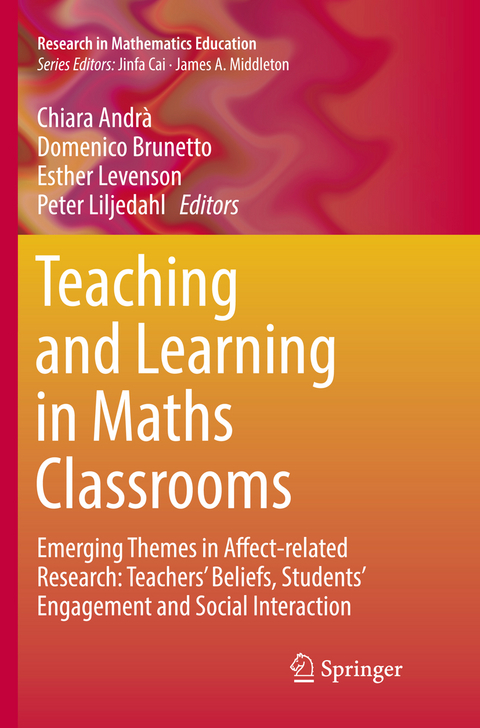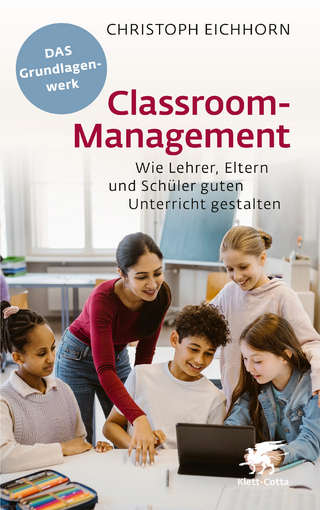
Teaching and Learning in Maths Classrooms
Springer International Publishing (Verlag)
978-3-319-84110-6 (ISBN)
Domenico Brunetto is a young researcher at the Mathematics Department, Polytechnic of Milan. His research interests are: the usage of multimedia (especially MOOCs) in classroom practice, the interaction between students in small and large groups, and network analysis. His current research project analyses and models student interactions, both online and in the classroom, using opinion dynamics models adapted to the teaching-learning context. Chiara Andrà is a post-doctoral fellow at the Mathematics Department, Polytechnic of Milan. Her research interests include: intuitions in probability, social interactions in small group activities in the math classroom, the transition from secondary to tertiary education, and mathematics teacher education. Esther Levenson is a researcher and instructor at the Department of Mathematics, Science and Technology Education at Tel-Aviv University, and at the Kibbuztim College of Education. In her PhD study she investigated mathematically and practically based explanations in the elementary school, especially individual preferences and socio-mathematical norms. Her current research interests include: fostering mathematical creativity among students and teachers, developing mathematical thinking among preschool children and their teachers, and the role that examples play in eliciting explanations. She serves on the editorial board of Educational Studies in Mathematics, and the Journal of Mathematics Teacher Education. Peter Liljedahl is an Associate Professor of Mathematics Education at the Faculty of Education, an associate member of the Department of Mathematics, and co-director of the David Wheeler Institute for Research in Mathematics Education at Simon Fraser University in Vancouver, CA. He is also the president of the IGPME. He is a former high school mathematics teacher who has kept his research interests close to the classroom. These include: creativity, insight, and discovery in mathematics teaching and learning; the role of the affective domain on the teaching and learning of mathematics; the professional growth of mathematics teachers; mathematical problem solving; and numeracy.
1 Teaching and learning in math classrooms.- 2 Foreword.- 3 Introduction.- Part I Classroom practices: explanation, problem-solving, patterning, decision-making, drawings and games - 4 Prospective primary teachers' beliefs regarding the roles of explanations in the classroom.- 5 Defining, drawing, and continuing repeating patterns: Preschool teachers' self-efficacy and knowledge. - 6 Primary school students' images of problem solving in mathematics.- 7 Secondary school mathematics teachers' conceptions on data-based decision-making: Insights from four Japanese cases.- 8 Teachers' activities during a mathematics lesson as seen in third graders' drawings- 9 Serious frivolity: exploring play in UK secondary mathematics classrooms.- Part II Teachers' beliefs, changing beliefs and the role of the environment.- 10 In-service math teachers' autobiographical narratives: the role of metaphors.- 11 A contribution to the relation between teachers' professed and enacted beliefs.- 12 Raising attainment: What might we learn from teachers' beliefs about their best and worst mathematics students?.- 13 Numeracy task design: A case of changing mathematics teaching practice.- 14 Math lessons: from flipped to amalgamated, from teacher- to learner-centered.- 15 Emotional expressions as a window to processes of change in a mathematics classroom's culture.- 16 Mathematics teachers' conceptions of the classroom environment.- Part III Understanding the undercurrents: tensions, inconsistencies and the social turn.- 17 Teacher tensions: the case of Naomi.- 18 Towards inconsistencies of parents' beliefs about teaching and learning mathematics.- 19 Evoking the feeling of uncertainty for enhancing conceptual knowledge.- 20 Criteria for identifying students as exceptional in a mathematical camp for 'gifted' students.- 21 Identity and rationality in classroom discussion: developing and testing an analytical toolkit.- 22 Developing an analyzing tool for dynamic mathematics-related student interaction regarding affect, cognition and participation.- Part IV Emerging themes in affect-related research: engagement, fear, perfectionism ...and assessment.- 23 Motivating desires for classroom engagement in the learning of mathematics.- 24 What are students afraid of when they say they are afraid of mathematics?.- 25 What is perfectionism in mathematical task solving?.- 26 Gender differences concerning pupils' beliefs on teaching methods and mathematical worldviews at lower secondary schools.- 27 "Every time I fell down (made a mistake), I could get up (correct)": affective factors in formative assessment practices with classroom connected technologies.- 28 Teachers' affect towards the external standardised assessment of students' mathematical competencies.- 29 Conclusion.
"Teaching and Learning in Maths Classrooms ... is an important book, as it presents a variety of emerging issues in the affective domain of mathematics education. ... I recommend this book to researchers in an early stage of their career, those who need a fresh perspective towards affect-related research and those looking to learn more from various research designs and analyses." (Woong Lim, MAA Reviews, October, 2017)
| Erscheinungsdatum | 05.03.2022 |
|---|---|
| Reihe/Serie | Research in Mathematics Education |
| Zusatzinfo | XXIII, 292 p. 13 illus., 4 illus. in color. |
| Verlagsort | Cham |
| Sprache | englisch |
| Maße | 155 x 235 mm |
| Gewicht | 486 g |
| Themenwelt | Sozialwissenschaften ► Pädagogik ► Schulpädagogik / Grundschule |
| Schlagworte | Assessment • Emotions, motivation, desideres, beliefs • Math education • Social Interaction |
| ISBN-10 | 3-319-84110-6 / 3319841106 |
| ISBN-13 | 978-3-319-84110-6 / 9783319841106 |
| Zustand | Neuware |
| Haben Sie eine Frage zum Produkt? |
aus dem Bereich


